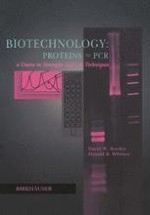1995 | OriginalPaper | Buchkapitel
Introducing Recombinant Molecules into Escherichia coli
verfasst von : David W. Burden, Donald B. Whitney
Erschienen in: BiotechnologyProteins to PCR
Verlag: Birkhäuser Boston
Enthalten in: Professional Book Archive
Aktivieren Sie unsere intelligente Suche, um passende Fachinhalte oder Patente zu finden.
Wählen Sie Textabschnitte aus um mit Künstlicher Intelligenz passenden Patente zu finden. powered by
Markieren Sie Textabschnitte, um KI-gestützt weitere passende Inhalte zu finden. powered by
The construction of a gene bank is only part of the cloning process. To clone DNA, the recombinant molecules must be introduced into an organism in which they are replicated, and as the cell grows and divides, also propagated. In genomic cloning, the recombinant DNA is normally introduced into the bacterium Escherichia coli.Many organisms can act as hosts for recombinant DNA, but E. coli is the most common. Chemically treated E. coli take up extracellular DNA in a process called transformation. Once the DNA is within the cell, the vector provides necessary information for the recombinant molecule to replicate and survive. As noted previously, a vector has an origin of replication (ori) and selectable markers, such as antibiotic resistance genes, both of which ensure the plasmid’s replication and survival.In Chapter 9 you created a gene bank by linking fragmented yeast genomic DNA into linearized vectors. By adjusting the concentrations of the DNA within the ligation reaction, a percentage of the ligated products are recombinant molecules containing both plasmid and yeast DNA. However, this pool of ligated DNA molecules contains recircularized vectors in addition to other products.In this experiment, you will introduce the ligated DNA into E. coli. This process first requires the preparation of competent E. coli to take up the DNA. Second, it requires performing the transformation, and, finally, selecting for transformed bacteria. Furthermore, a strategy will be employed that differentiates between cells harboring recircularized and recombinant plasmids.
